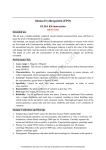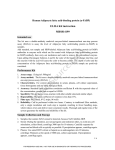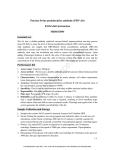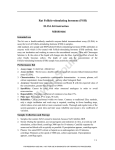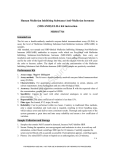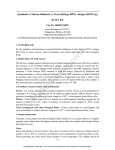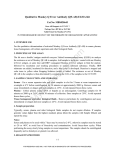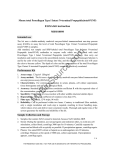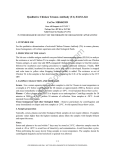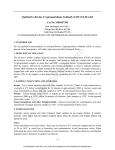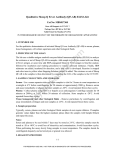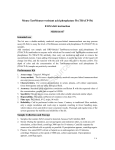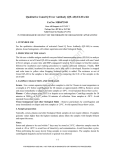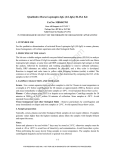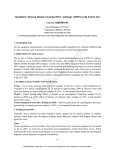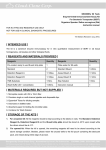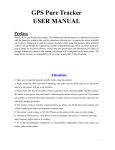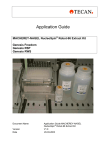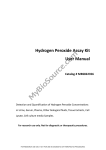Download MBS810234 - MyBioSource
Transcript
Rat Nuclear factor-kappaB p65 (NF-kappaB p65) ELISA Kit instruction MBS810234 Intended use Performance Kit So ur ce .c om The kit uses a double-antibody sandwich enzyme-linked immunosorbent assay (ELISA) to assay the level of Nuclear factor-kappaB p65 (NF-kappaB p65) in samples. Add standard, test sample and HRP-labeled Nuclear factor-kappaB p65 (NF-kappaB p65) antibodies to enzyme wells which are Pre-coated with Nuclear factor-kappaB p65 (NF-kappaB p65) antibody, then carry out incubation and wash to remove the uncombined enzyme. Upon adding Chromogen Solution A and B, the color of the liquid will change into blue, and the reaction with the acid will cause the color to become yellow. The depth of color and the concentration of the Nuclear factor-kappaB p65 (NF-kappaB p65) sample are positively correlated. M yB io 1. Assay range: 1.25ng/ml- 80ng/ml 2. Assay method: :The kit uses a double-antibody sandwich enzyme-linked immunosorbent assay (ELISA). 3. Characteristics: : For quantitative concentration determination in serum, plasma, cell culture supernatant, tissue homogenate and any other biological fluid. 4. Accuracy: Standard linear regression correlation coefficient R with the expected value of the concentration, greater than or equal to 0.9900. 5. Specificity: Cannot be used with other structural analogues in order to avoid cross-reaction. 6. Repeatability: The plate coefficient of variation is less than 15%. 7. Plate type: Pre-coated, 8*12 strips, 96 wells 8. Reliability: Can be performed within two hours. Contrary to traditional Elisa methods, only a single incubation and wash step is required, resulting in fewer handling steps, which reduce errors and deliver more consistent results. Thorough and regular tests of the system guarantee a great intra and inter assay reliability and ensure a low coefficient of variation. Sample Collection and Storage 1. Samples that contain NaN3 cannot be detected, because NaN3 inhibits HRP. 2. Serum: During the operation, use non-pyrogenic and endotoxin in vitro, to avoid any cell stimulation, collect blood; centrifuge 3000 rpm for 10 minutes. Carefully separate the serum and red blood cells as quickly as possible. If precipitation appears, centrifuge again. 3. Plasma: Use suited EDTA citrate or heparin as an anticoagulant, mix 20 minutes, centrifuge 30minutes at the speed of 3000 rpm, collect supernatant. If precipitation 1/6 FOR RESEARCH USE ONLY. NOT FOR USE IN DIAGNOSTIC OR THERAPEUTIC PROCEDURES. So ur ce .c om appears, centrifuge again. 4. Homogenate: Homogenize with saline buffer and centrifuge for 10minutes at the speed of 3000 rpm, then get supernatant for detection. 5. Urine: Collect with sterile container, centrifuge for 20 minutes at 2000-3000 rpm. Collect supernatant. If precipitation appears, centrifuge again. Use this description to also process hydrothorax and cerebrospinal fluid. 6. Cell culture supernatant: When secretory components want to be detected, collect culture medium with a sterile container, centrifuge for 20 minutes at 2000-3000 rpm, collect supernatant. When the composition of cells is detected, dilute cell suspension with PBS(pH 7,2-7,4); work with a cell concentration of 1 million cells/ml, repeated freeze-thaw cycles, damage cells and release of intracellular components, centrifuge for 20 minutes at 2000-3000 rpm. Collect supernatant. If precipitation appears, centrifuge again. 7. Tissue samples: After cutting samples, check the weight, add PBS(PH7.2-7.4), Rapidly freeze with liquid nitrogen, keep samples at 2-8℃after melting, add PBS(PH7.4), Homogenize by hand or Grinders, centrifuge for 20 minutes at the speed of 2000-3000 rpm. Collect supernatant. 8. Storage: Serum, plasma, and cell culture fluid samples must be used within 7 days. May be stored at 2-8℃, otherwise samples must stored at -20℃(=2months) or -80℃(=6months) to avoid loss of bioactivity and contamination. Avoid freeze-thaw cycles. When performing the assay slowly bring samples to room temperature. DO NOT USE HEAT-TREATED SPECIMENS. Materials Required but not Supplied yB io Standard micro-plate reader (450nm). Precision pipettes and Disposable pipette tips. 37 ℃ incubator. Distilled or de-ionized water. Data analysis and graphing software. Tubes to prepare standard or sample dilutions. Adjustable 10ml -100ml pipettes for reagent preparation. 100 ml and 1 liter graduated cylinders. Absorbent paper. M 1. 2. 3. 4. 5. 6. 7. 8. 9. Warnings and Precautions 1. The kit contains material and a small amount of sodium azide. Avoid contact with eyes, skin and mucous membrane. In case of contact, wash affected area with plenty of water. 2. Bring kit components out of the fridge for at least 30minutes before its use. If the Enzyme coated plates are not used immediately after being opened, the remaining plates should be stored in a sealed bag. The concentrated washing liquid, which was removed from the refrigerator, may contain some crystals. This is a normal phenomenon. Please completely dissolve before used. 3. The operation should be carried out in strict accordance with the instructions. Test results 2/6 FOR RESEARCH USE ONLY. NOT FOR USE IN DIAGNOSTIC OR THERAPEUTIC PROCEDURES. Materials Supplied So ur ce .c om must be based on the readings of the Enzyme reader. 4. For each step, add sample by using a pipette, which should be calibrated frequently, in order to avoid unnecessary experimental errors. 5. In order to avoid cross-contamination, it is forbidden to re-use the tips and seal plate membrane with your hands. 6. All liquid components should be well mixed before its use. 7. Samples should be collected in pyrogen/endotoxin-free tubes. 8. Samples should be frozen if not analyzed shortly after collection. Avoid multiple freeze-thaw cycles of the samples. Thaw completely and mix well prior to analysis. 9. When possible, avoid use of badly hemolyzed or lipemic sera. If large amounts of particulates are present, centrifuge or filter prior to analysis. 10. It is recommended that all standards, controls and samples be run in duplicate. 11. The idle reagents shall be put up or covered. Do not use reagents with different batches, and use them before expired date. 12. Read absorbances within 2 hours of assay completion. 13. The substrate B is light sensitive. Avoid prolonged exposure to light. Also avoid contact between Stabilized Chromogen and metal. 14. All samples, washing buffer and each kind of waste should be processed according to infective material procedures. 1×96WELLS 12*8strips 0.6ml 6.0ml 6.0ml 6.0ml RECONSTITUTION Ready to use Dilute according to instructions Ready-to-use Ready-to-use Ready-to-use 20ml Dilute according to instructions Chromogen Solution A 6.0ml Ready-to-use Chromogen Solution B 6.0ml Ready-to-use Stop Solution Microplate Sealers 6.0ml 2 Ready-to-use Ready-to-use yB io REAGENTS(store at 2-8℃) 96 wells miorou Standard(80ng/ml) Standard diluent Sample diluent HRP-Conjugate reagent M 20X Wash solution User manual 1 Ready-to-use Sealed bags 1 Ready-to-use Note: Dilute the Standard with Standard diluents, as follows: 80、40、20、10、5、0ng/ml Reagent Preparation 20 × dilution of washing buffer: distilled water, diluted by 1:20, or 1 copy of the 20 × washing buffer plus 19 copies of the distilled water Washing Method: : 3/6 FOR RESEARCH USE ONLY. NOT FOR USE IN DIAGNOSTIC OR THERAPEUTIC PROCEDURES. Manually washing method: Empty the plate by inverting it and shaking the content out over the sink, and tap it on the absorbent papers to dry. Add at least 0.35ml washing solution 1x into each well, and soak the plate for 1~2 minutes. Repeat this process 5 times. Automatic washing method: If there is an automatic washing machine, it should only be used in the test when you are quite familiar with its function and performance. Operation Steps M yB io So ur ce .c om 1. The quantity of the strips depends on the quantity to-be-tested samples and the standards. It is suggested to duplicate each standard and blank well. Every sample should be made according to your required quantity, and try to use the duplicated wells for samples as well. 2. Set blank wells, standard wells, and test sample wells respectively: (1) Blank wells: do not add samples and horseradish peroxidase (HRP), other operations are the same. (2) Standard wells: Add standard 50µl to Standard wells. (3) Test sample wells: Add 40µl of sample dilution and then add 10µl of undiluted testing sample (sample final dilution factor is 5). (4) Add 50µl of horseradish peroxidase (HRP) into each well, except blank well. Then seal the plate, and gently shake, then incubate 60 minutes at 37 . 3. Discard Liquid excess, drying, fill each well with diluted washing liquid, mix and shake for 30 seconds, discard the washing liquid and tap the plate into absorbent papers to dry. Repeat five times, and then pat dry. 4. Add 50µl of chromogen solution A to each well, and then add 50µl of chromogen solution B to each well. Gently shake and incubate for 10 minutes at 37℃ away from light. 5. Stop: Add Stop Solution 50µl into each well to stop the reaction (the blue changes into yellow immediately). 6. Final measurement: Take blank well as zero, measure the optical density (OD) at 450 nm wavelength which should be carried out within 15 minutes after adding the stop solution. 7. According to standards’ concentration and the corresponding OD values, calculate out the standard curve linear regression equation, and then apply the OD values of the sample on the regression equation to calculate the corresponding sample’s concentration. It is acceptable to use a variety of software to make calculations. 4/6 FOR RESEARCH USE ONLY. NOT FOR USE IN DIAGNOSTIC OR THERAPEUTIC PROCEDURES. Summary Procedures Prepare reagents, samples and standard Add prepared sample and standard and HRP-Conjugate Reagent, incubate for 60 minutes at 37 ℃ .c Add stop solution om Wash plate five times and add Chromogen Solution A and B, incubate for 15 minutes at 37 ℃ So ur ce Measure within 15minutes Calculation Determining the Results M yB io 1. This standard curve is used to determine the amount in an unknown sample. The standard curve is generated by plotting the average O.D. (450 nm) obtained for each of the six standard concentrations on the vertical (Y) axis versus the corresponding concentration on the horizontal (X) axis. 2. First, calculate the mean O.D. value for each standard and sample. All O.D. values, are subtracted by the mean value of the zero standard before result interpretation. Construct the standard curve using graph paper or statistical software.. 3. To determine the amount in each sample, first locate the O.D. value on the Y-axis and extend a horizontal line to the standard curve. At the point of intersection, draw a vertical line to the X-axis and read the corresponding concentration. 4. Any variation in the operator, pipetting and washing technique, incubation time or temperature, and kit age can cause a variation in the result. Each user should obtain their own standard curve. 5/6 FOR RESEARCH USE ONLY. NOT FOR USE IN DIAGNOSTIC OR THERAPEUTIC PROCEDURES. om .c So ur ce Package size: 96 determinations Storage: : 2-8℃. yB io Validity: : Six months M PLEASE CAREFULLY READ THIS INSTRUCTION MANUAL BEFORE USE. TO BE USED ONLY FOR RESEARCH PURPOSES, NOT TO BE USED FOR MEDICAL DIAGNOSIS. 6/6 FOR RESEARCH USE ONLY. NOT FOR USE IN DIAGNOSTIC OR THERAPEUTIC PROCEDURES.






